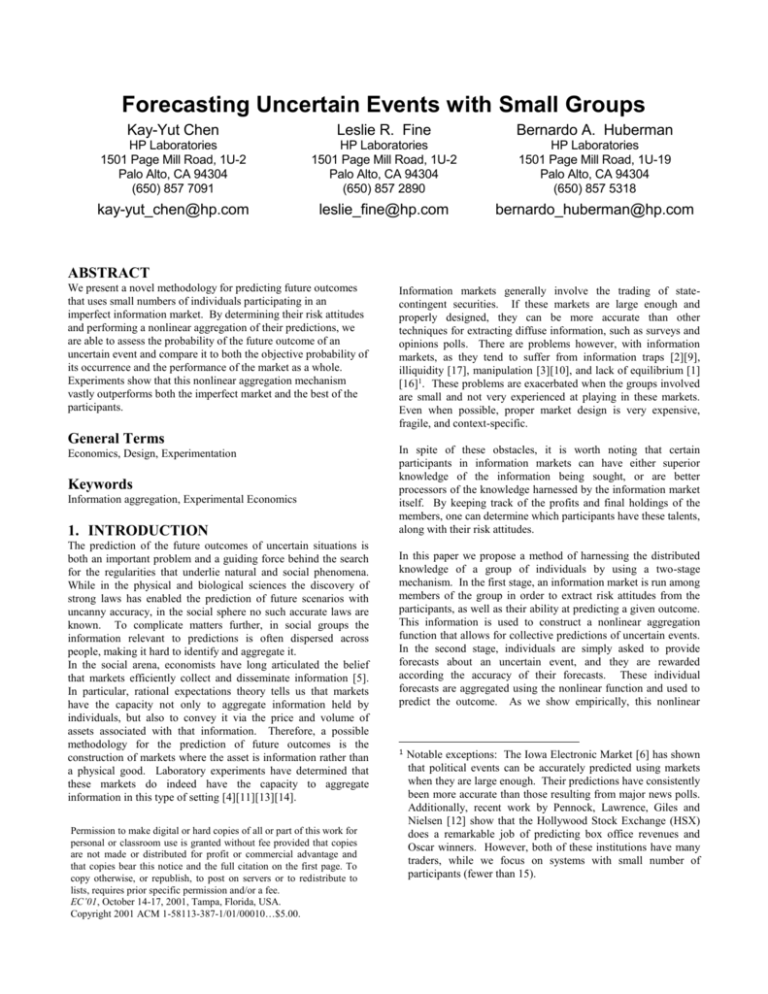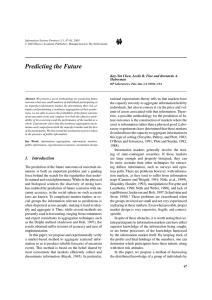Kay-Yut Chen, Leslie Fine and Bernardo Huberman
advertisement

Forecasting Uncertain Events with Small Groups
Kay-Yut Chen
Leslie R. Fine
Bernardo A. Huberman
HP Laboratories
1501 Page Mill Road, 1U-2
Palo Alto, CA 94304
(650) 857 7091
HP Laboratories
1501 Page Mill Road, 1U-2
Palo Alto, CA 94304
(650) 857 2890
HP Laboratories
1501 Page Mill Road, 1U-19
Palo Alto, CA 94304
(650) 857 5318
kay-yut_chen@hp.com
leslie_fine@hp.com
bernardo_huberman@hp.com
ABSTRACT
We present a novel methodology for predicting future outcomes
that uses small numbers of individuals participating in an
imperfect information market. By determining their risk attitudes
and performing a nonlinear aggregation of their predictions, we
are able to assess the probability of the future outcome of an
uncertain event and compare it to both the objective probability of
its occurrence and the performance of the market as a whole.
Experiments show that this nonlinear aggregation mechanism
vastly outperforms both the imperfect market and the best of the
participants.
General Terms
Economics, Design, Experimentation
Keywords
Information aggregation, Experimental Economics
1. INTRODUCTION
The prediction of the future outcomes of uncertain situations is
both an important problem and a guiding force behind the search
for the regularities that underlie natural and social phenomena.
While in the physical and biological sciences the discovery of
strong laws has enabled the prediction of future scenarios with
uncanny accuracy, in the social sphere no such accurate laws are
known. To complicate matters further, in social groups the
information relevant to predictions is often dispersed across
people, making it hard to identify and aggregate it.
In the social arena, economists have long articulated the belief
that markets efficiently collect and disseminate information [5].
In particular, rational expectations theory tells us that markets
have the capacity not only to aggregate information held by
individuals, but also to convey it via the price and volume of
assets associated with that information. Therefore, a possible
methodology for the prediction of future outcomes is the
construction of markets where the asset is information rather than
a physical good. Laboratory experiments have determined that
these markets do indeed have the capacity to aggregate
information in this type of setting [4][11][13][14].
Permission to make digital or hard copies of all or part of this work for
personal or classroom use is granted without fee provided that copies
are not made or distributed for profit or commercial advantage and
that copies bear this notice and the full citation on the first page. To
copy otherwise, or republish, to post on servers or to redistribute to
lists, requires prior specific permission and/or a fee.
EC’01, October 14-17, 2001, Tampa, Florida, USA.
Copyright 2001 ACM 1-58113-387-1/01/00010…$5.00.
Information markets generally involve the trading of statecontingent securities. If these markets are large enough and
properly designed, they can be more accurate than other
techniques for extracting diffuse information, such as surveys and
opinions polls. There are problems however, with information
markets, as they tend to suffer from information traps [2][9],
illiquidity [17], manipulation [3][10], and lack of equilibrium [1]
[16]1. These problems are exacerbated when the groups involved
are small and not very experienced at playing in these markets.
Even when possible, proper market design is very expensive,
fragile, and context-specific.
In spite of these obstacles, it is worth noting that certain
participants in information markets can have either superior
knowledge of the information being sought, or are better
processors of the knowledge harnessed by the information market
itself. By keeping track of the profits and final holdings of the
members, one can determine which participants have these talents,
along with their risk attitudes.
In this paper we propose a method of harnessing the distributed
knowledge of a group of individuals by using a two-stage
mechanism. In the first stage, an information market is run among
members of the group in order to extract risk attitudes from the
participants, as well as their ability at predicting a given outcome.
This information is used to construct a nonlinear aggregation
function that allows for collective predictions of uncertain events.
In the second stage, individuals are simply asked to provide
forecasts about an uncertain event, and they are rewarded
according the accuracy of their forecasts. These individual
forecasts are aggregated using the nonlinear function and used to
predict the outcome. As we show empirically, this nonlinear
1
Notable exceptions: The Iowa Electronic Market [6] has shown
that political events can be accurately predicted using markets
when they are large enough. Their predictions have consistently
been more accurate than those resulting from major news polls.
Additionally, recent work by Pennock, Lawrence, Giles and
Nielsen [12] show that the Hollywood Stock Exchange (HSX)
does a remarkable job of predicting box office revenues and
Oscar winners. However, both of these institutions have many
traders, while we focus on systems with small number of
participants (fewer than 15).
aggregation mechanism vastly outperforms both the imperfect
market and the best of the participants.
2. Aggregation Mechanism Design
In order to construct the aggregation function, we first notice that
in ideal settings, it is easy to compute the true posterior
probabilities using Bayes’ rule.
If individuals receive
independent information conditioned on the true outcome, their
prior beliefs are uniform (no other information is available other
than the event sequence), and they each report the true posterior
probabilities given their information, then the probability of an
outcome s, conditioned on all of their observed information I, is
given by:
Ps | I
p s1 p s2 ... p s N
p
s
s1
p s2 ... p s N
(1)
where psi is the probability that individual i (i=1…N) assigns to
outcome s (please see Appendix 1 for a discussion). This result
allows us simply to take the individual predictions, multiply them
together, and normalize them in order to get an aggregate
probability distribution. The issue becomes how to design a
mechanism that elicits truthful reporting from individuals. We
demonstrate in Appendix 2 that the following mechanism will
induce risk neutral utility maximizing individuals to report their
prior probabilities truthfully. We ask each player to report a
vector of perceived state-probabilities, {q1,q2,…qN} with the
constraint that the vector sums to one. Then the true state x is
revealed and each player paid c1+c2*log(qx), where c1 and c2 are
positive numbers.
While this very simple method might seem to aggregate dispersed
information well, it suffers from the fact that, due to their risk
attitude, most individuals do not necessarily report their true
posterior probabilities conditioned on their information. In most
realistic situations, a risk averse person will report a probability
distribution that is flatter than her true beliefs as she tends to
spread her bets among all possible outcomes. In the extreme case
of risk aversion, an individual will report a flat probability
distribution regardless of her information. In this case, no
predictive information is revealed by her report. Conversely, a
risk-loving individual will tend to report a probability distribution
that is more sharply peaked around a particular prediction, and in
the extreme case of risk loving behavior a subject’s optimal
response will be to put all his weight on the most probable state
according to his observations. In this case, his report will contain
some, but not all the information contained in his observations.
In order to account for both the diverse levels of risk aversion and
information strengths, we add a stage to the mechanism. Before
individuals are asked to report their beliefs, they participate in an
information market designed to elicit their risk attitudes and other
relevant behavioral information. This information market is
driven by the same information structure in the reporting game.
We use information markets to capture the behavioral information
that is needed to derive the correct aggregation function. Note
that, although the participant pool is too small for the market to
act perfectly efficiently, it is a powerful enough mechanism to
help us illicit the needed information.
The nonlinear aggregation function that we constructed is of the
form:
Ps | I
p s11 p s22 ... p sNN
p p ... p
1
s
s1
2
s2
N
sN
(2)
where i is the exponent assigned to individual i. The role of i
is to help recover the true posterior probabilities from individual
i’s report. The value of for a risk neutral individual is one, as he
should report the true probabilities coming out of his information.
For a risk averse individual, i is greater than one so as to
compensate for the flat distribution that he reports. The reverse,
namely i smaller than one, applies to risk loving individuals. In
terms of both the market performance and the individual holdings
and risk behavior, a simple functional form for i is given by
i=r(V i /i)c
(3)
where r is a parameter that captures the risk attitude of the whole
market and is reflected in the market prices of the assets, Vi is the
utility of individual i, and i is the variance of his holdings over
time. We use c as a normalization factor so that if r=1, ∑i equals
the number of individuals. Thus the problem lies in the actual
determination of both the risk attitudes of the market as a whole
and of the individual players.
To do so, notice that if the market is perfectly efficient then the
sum of the prices of the securities should be exactly equal to the
payoff of the winning security. However, in the thin markets
characterized here, this efficiency condition was rarely met.
Moreover, although prices that do not sum to the winning payoff
indicate an arbitrage opportunity, it was rarely possible to realize
this opportunity with a portfolio purchase (once again, due to the
thinness of the market). However, we can use these facts to our
advantage. If the sum of the prices is below the winning payoff,
then we can infer that the market is risk-averse, while if the price
is above this payoff then the market exhibits risk-loving behavior.
Thus, the ratio of the winning payoff to the sum of the prices
provides a proxy for the risk attitude of the market as a whole.
The ratio of value to risk, (Vi/i), captures individual risk attitudes
and predictive power. An individual’s value Vi is given by the
market prices multiplied by his holdings, summed over all the
securities. As in portfolio theory [8], his amount of risk can be
measured by the variance of his values using normalized market
prices as probabilities of the possible outcomes.
3. Experimental Design
In order to test this mechanism we conducted a number of
experiments at Hewlett-Packard Laboratories, in Palo Alto,
California. The subjects were undergraduate and graduate
students at Stanford University and knew the experimental
parameters discussed below, as they were part of the instructions
and training for the sessions. The five sessions were run with
eight to thirteen subjects in each.
The two-stage mechanism was implemented in a laboratory
setting. Possible outcomes were referred to as “states” in the
experiments. There were 10 possible states, A through J, in all the
experiments.
Each had an Arrow-Debreu2 state security
associated with it. The information available to the subjects
consisted of observed sets of random draws from an urn with
replacement. After privately drawing the state for the ensuing
period, we filled the urn with one ball for each state, plus an
additional two balls for the just-drawn true state security. Thus it
is slightly more likely to observe a ball for the true state than
others.
The amount of information given to the subjects was controlled by
letting them observe different number of draws from the urn.
Three types of information structures were used to ensure that the
results obtained were robust. In the first treatment, each subject
received three draws from the urn, with replacement. In the
second treatment, half of the subjects received five draws with
replacement, and the other half received one. In a third treatment,
half of the subjects received a random number of draws
(averaging three, and also set such that the total number of draws
in the community was 3N) and the other half received three, again
with replacement.
The information market we constructed consisted of an artificial
call market in which the securities were traded. The states were
equally likely and randomly drawn. If a state occurred, the
associated state security paid off at a value of 1,000 francs3.
Hence, the expected value of any given security, a priori, was 100
francs. Subjects were provided with some securities and francs at
the beginning of each period.
Each period consisted of six rounds, lasting 90 seconds each. At
the end of each round, the bids and asks were gathered and a
market price and volume was determined. The transactions were
then completed and another call round began. At the end of six
trading rounds the period was over, the true state security was
revealed, and subjects were paid according to the holdings of that
security. This procedure was then repeated in the next period,
with no correlation between the states drawn in each period.
In the second-stage, every subject played under the same
information structure as in the first stage, although the draws and
the true states were independent from those in the first. Each
period they received their draws from the urn and 100 tickets.
They were asked to distribute these tickets across the 10 states
with the constraint that all 100 tickets must be spent each period
and that at least one ticket is spent on each state. Since the
fraction of tickets spent determines psi, this implies that psi is
never zero. The subjects were given a chart that told them how
many francs they would earn upon the realization of the true state
as a function of the number of tickets spent on the true state
security. The payoff is a linear function of the log of the
2
3
These securities have lottery-like properties, and they pay off
one unit contingent on the positive outcome of an event linked
to that security, and zero otherwise.
An experimental currency, exchanged for dollars at the end of
the experiment according to an announced exchange rate.
percentage of tickets placed in the winning state (Please see
Appendix 2 for a discussion of the payoff function). The chart the
subjects received showed the payoff for every possible ticket
expenditure, and an excerpt from the chart is shown below.
Table 1: Payoff Chart for Reporting Game
Number of
Tickets
Possible
Payoff
Number of
Tickets
Possible
Payoff
1
10
20
30
40
33
516
662
747
808
50
60
70
80
90
854
893
925
953
978
A total of five experiments were conducted. The number of
subjects in the experiments ranged from eight to thirteen. The
speed of the experiments depended on how fast the subjects were
making their decisions, the length of the training sessions and a
number of other variables. Therefore, we have completed
different number of periods in different experiments. The
following table provides a summary.
Table 2: Summary of Experiments
Number
Experiment
of
Number
Subjects
Number of Number of
Call
Rounds of
Market Reporting
Periods
Game
1
2
13
9
3
6
7
18
3
11
7
29
4
8
7
25
5
10
10
30
Information
Structure
3 draws
3 draws
5 draws (6 subjects)
1 draw (5 subjects)
5 draws (4 subjects)
1 draw (4 subjects)
Random (5 subjects)
3 draws (5 subjects)
4. Analysis
Notice that if the aggregation mechanism were perfect, the
probability distribution of the states would be as if one person had
seen all of the information available to the community. Therefore,
the probability distribution conditioned on all the information acts
as a benchmark to which we can compare alternative aggregation
mechanisms. In order to compute it, recall that there are twelve
balls in the information urn, three for the true state and one for
each of the other nine states. Using Bayes’ rule one obtains the
omniscient probability distribution, i.e.
#( s )
#( s )
3 1
12
12
P( s | O) #( s) #( s )
3 1
12
s 12
(4)
where s denotes the states, O is a string of observations, #(s) is the
number of draws of the state s in the string, and #( s ) is the
number of draws of all other states.
Leibler number, which was used to characterize the difference
between the probability distributions coming out of a given
mechanism and the omniscient probability.
Once this benchmark is created, the next step is to find a measure
to compare probabilities provided by different aggregation
mechanisms to this benchmark. The obvious measure to use is the
Kullback-Leibler measure, also known as the relative entropy [7].
The Kullback-Leibler measure of two probability distributions p
and q is given by:
Table 3: Kullback-Leibler Numbers, by Experiment
p
KL p, q E p log
q
Best
Player
Simple
Nonlinear
Aggregation Aggregation
Function
Function
1.977 (0.312) 1.222 (0.650) 0.844 (0.599) 1.105 (2.331) 0.553 (1.057)
1.501 (0.618) 1.112 (0.594) 1.128 (0.389) 0.207 (0.215) 0.214 (0.195)
(5)
where p is the “true” distribution. In the case of finite number of
discrete states, the above Equation (5) can be rewritten as:
p
KL p, q p s log s
s
qs
No
Market
Information Prediction
(6)
It can be shown that KL(p,q)=0 if and only if the distribution p
and q are identical, and that KL(p,q) 0. A smaller KullbackLeibler number indicates that two probabilities are closer to each
other.
Furthermore, the Kullback-Leibler measure of the joint
distribution of multiple independent events is the sum of the
Kullback-Leibler measures of the individual events. Since
periods within an experiment were independent events, the sum or
average (across periods) of Kullback-Leibler measures is a good
summary statistics of the whole experiment.
5. Results
Three information aggregation mechanisms were compared to the
benchmark distribution given by Equation (6) by using the
Kullback-Leibler measure. In addition, we also report the
Kullback-Leibler measures of the “no information” prediction
(uniform distribution over all the possible states) and the
predictions of the best individual.
The “no information”
prediction serves as the first baseline to determine if any
information is contained in the predictions of the mechanisms. If
a mechanism is really aggregating information, then it should be
doing at least as well as the best individual. Predictions of the
best individual serve as the second baseline, which help us to
determine if information aggregation indeed occurred in the
experiments.
The first of the three information aggregation mechanisms is the
market prediction. The market prediction was calculated using
the last traded prices of the assets. We used the last traded prices
rather than the current round’s price because sometimes there was
no trade in a given asset in a given round. From these prices, we
inferred a probability distribution on the states. The second and
the third mechanisms are the simple aggregation function given by
the risk neutral formula in Equation (1), and the market-based
nonlinear aggregation function in Equation (2).
The results are shown in Table 3. The entries are the average
values and standard deviations (in parentheses) of the Kullback-
1.689 (0.576) 1.053 (1.083) 0.876 (0.646) 0.489 (0.754) 0.414 (0.404)
1.635 (0.570) 1.136 (0.193) 1.074 (0.462) 0.253 (0.325) 0.413 (0.260)
1.640 (0.598) 1.371 (0.661) 1.164 (0.944) 0.478 (0.568) 0.395 (0.407)
As can easily be seen, the nonlinear aggregation function worked
extremely well in all the experiments. It resulted in significantly
lower Kullback-Leibler numbers than the no information case, the
market prediction, and the best a single player could do. In fact, it
performed almost three times as well as the information market.
Furthermore, the nonlinear aggregation function exhibited a
smaller standard deviation than the market prediction, which
indicates that the quality of its predictions, as measured by the
Kullback-Leibler number, is more consistent than that of the
market. In three of five cases, it also offered substantial
improvements over the simple aggregation function.
The results displayed in the second column show that the market
was not sufficiently liquid to aggregate information properly, and
it was only marginally better than the a priori no information case.
In almost all cases, the best player in the reporting game conveyed
more information about the probability distribution than the
market did. However, even in situations where the market
performs quite poorly, it does provide some information, enough
to help us construct an aggregation function with appropriate
exponents.
All these results are illustrated in Figure 1, where we show the
probability distributions generated by the market mechanisms, the
best individual in a typical experiment, the nonlinear aggregation
function, as well as the omniscient probability distribution
generated by Equation (4)4. Notice that the nonlinear aggregation
function exhibits a functional form very similar to the omniscient
probability, and with low variance compared to the other
mechanisms. This is to be contrasted with the market prediction,
which exhibits information traps at state I and F, and a much
larger variance.
4 While
different, independent events are used for the market stage
and the reporting stage, we found one period in both stages that
contained the exact same information. Thus, we can compare
results from these two periods in this figure.
possible to set up an initial market to obtain consistent measures
of skills and risk attitudes and then use the reporting mechanism
to extract and aggregate information in the future.
Figure 1
Accuracy of Prediction, by Mechanism
Best Individual
Market Prices
Nonlinear Aggregation
Omniscient
Probability
1.0
0.8
0.6
0.4
0.2
0.0
A
B
C
D
E
F
G
H
I
J
States
These experiments confirm the utility of our nonlinear
aggregation mechanism for making good forecasts of uncertain
outcomes. This nonlinear function applies the predictions of a
group of people whose individual risk attitudes can be extracted
by making them participate in an information market. Equally
important, our results show that many of the shortcomings
associated with information markets can be bypassed by this two
stage method, without having to design and resort to complicated
market games. In this context it is worth pointing out that even
with such small groups we were able to obtain information whose
accuracy, measured by Kullback-Leibler, surpasses by a factor of
seven even more complicated institutions such as pari-mutuel
games [15].
Lastly, unlike the standard information aggregation implied by the
Condorcet theorem, our mechanism allows us to extract
probability distributions rather than the validity of a discrete
choice obtained via a majority vote. Moreover, our mechanism
provides a signal even in situations when an overall system itself
does not contain accurate information as to the outcome. Equally
important, unlike Condorcet our two-stage mechanism does not
demand risk neutrality and access to the same information by all
participants in the system.
6. Conclusions
Accurate predictions are essential to individuals and
organizations. For large communities, information relevant to
forecasts is often dispersed across people, frequently in different
geographical areas. Examples include forecasting sales of a
product, aggregating the financial predictions of the venture
capital community, and public opinion polls. The methodology
described in this paper addresses many of the needs to aggregate
this information accurately and with the correct incentives. One
can take past predictive performance of participants in
information markets and create weighting schemes that will help
predict future events, even if they are not the same event on which
the performance was measured. Furthermore, our two-stage
approach can improve upon predictions by harnessing distributed
knowledge in a manner that alleviates problems with low levels of
participation. The typical business forecast cycle also lends itself
to this approach. Since forecasts cycles in organizations typically
involve the prediction of similar events on a periodic basis, it is
Obviously, this approach can also be extended to work across
organizations. One possible use is to aggregate and create
consensus estimates in the financial analyst community. Another
one is to provide the venture capital community a way of forming
predictions about the viability of new ventures. The Hollywood
Stock Exchange has shown that information markets can be used
to predict movie ticket sales, which are tremendously important to
studio executives. In the same vein, our methodology can be used
with smaller groups of movie screen test subjects to create
forecasts before a movie is released. One can imagine a world in
which focus groups are no longer run solely on survey questions
and discussions, but where each member has a financial stake in
the information coming out of the focus group.
The rapid advances of information technologies and the
understanding of information economics have opened up many
new possibilities for applying mechanism design to gather and
analyze information. This paper discusses one such design and
provides empirical evidence about its validity. Although the
results we presented are particular to events with finite number of
outcomes and assumptions of independent information, they can
be generalized to continuous state space and non-independent
information structure.
We are currently pursuing these
extensions. Equally intriguing is the possibility of having this
mechanism in the context of the Web, thus enabling information
aggregation
over
large
geographical
areas,
perhaps
asynchronously. This leads to issues of information cascades and
the optimal time to keep an aggregation market open, which we
will explore in turn.
7. References
[1] Anderson, L. and C. Holt. Information Cascades in the
Laboratory. American Economic Review, 87 (1997), 847862.
[2] Camerer, C. and K. Weigelt. Information Mirages in
Experimental Asset Markets. Journal of Business, 64 (1991),
463-493.
[3] Forsythe, R. and R. Lundholm. Information Aggregation in
an Experimental Market. Econometrica, 58 (1990), 309-347.
[4] Forsythe, R., T. Palfrey, and C. Plott. asset Valuation in an
Experimental Market. Econometrica, 50 (1982), 537-567.
[5] Hayek, F. The Use of Knowledge in Society. American
Economic Review, XXXV, No. 4 (1945), 519-30.
[6] Iowa Electronic Markets. http.//www.biz.uiowa.edu/iem.
[7] Kullback, S. and R.A. Leibler. On Information and
Sufficiency. Annals of Mathematical Statistics, 22 (1952),
79-86.
[8] Markowitz, H. Portfolio Selection, Wiley and Sons, NY,
1959.
[9] Nöth, M., C. Camerer, C. Plott, and M. Weber. Information
Traps in Experimental Asset Markets. Submitted to Review
of Financial Studies (1999).
[10] Nöth, M., and M. Weber. Information Aggregation with
Random Ordering: Cascades and Overconfidence.
University of Mannheim, Discussion Paper, presented at the
Summer 1998 ESA Meetings (1998).
By independence,
Ps | O1 , O2 ,..., On
Ps'| O1 , O2 ,..., On
P(s|O1,O2,…On) =
[11] O’Brien, J. and S. Srivastava. Dynamic Stock Markets with
Multiple Assets. Journal of Finance, 46 (1991), 1811-1838.
[12] Pennock, D., S. Lawrence, C. Giles, and F. Nielsen. The
Power of Play: Efficient and Forecast Accuracy in Web
Market Games. NEC Research Institute Technical Report
2000-168 (2000).
[13] Plott, C. and S. Sunder. Efficiency of Experimental Security
Markets with Insider Information: An Application of
Rational Expectations Models. Journal of Political
Economy, 90 (1982), 663-698.
s'
By Lemma 2 below, P(s|O1,O2,…On+1)
Ps | O1 , O2 ,..., On Ps | On 1
Ps'| O1 , O2 ,..., On Ps'| On1
s'
[14] Plott, C. and S. Sunder. Rational Expectations and the
n
Aggregation of Diverse Information in Laboratory Security
Markets. Econometrica, 56 (1988), 1085-1118.
P s | O
i
i 1
[15] Plott, C., J. Wit and W. Yang. Pari-mutuel Betting Markets
as Information Aggregation Devices: Experimental Results.
Social Science Working Paper 986, California Institute of
Technology (1997).
n
Ps'| O
i
i 1
n
s'
P s ' | O
[16] Scharfstein, D. and J. Stein. Herd Behavior and Investment.
American Economic Review, 80 (1990), 465-479.
[17] Sunder, S. Markets for Information: Experimental Evidence.
Econometrica, 60 (1992), 667-695.
P s | On 1
s'
i
i 1
n
Ps' '| O
Ps ' | On 1
i
i 1
s ''
8. Appendices
n
8.1 Appendix 1: Conditional Probabilities and
Products of Reports
Lemma: If: O1 through On are independent observations
conditioned on a given state and the a priori beliefs of the
probabilities of the states are uniform
Ps | O Ps | O
n 1
i
i 1
n
Ps'| O Ps'| O
n 1
i
s'
i 1
n
P s | O
n 1
i
Then P(s|O1,O2,…On) =
i 1
n
Ps'| O
.
i
s'
i 1
In other words, if N people observe independent information
about the likelihood of a given state and they report those
probabilities, one can find the probability conditioned on all of
their observations by multiplying their reported probabilities and
then normalizing the results.
Proof (by induction):
For N=1, P(s|O) =
Ps | O
Ps | O
Ps | O .
P
s
'
|
O
1
s'
Assume it is true for N.
P s | O
i
i 1
n 1
Ps | O
i
s'
i 1
8.2 Appendix 2: Risk Neutrality and Log
Payoff Functions in the Reporting Game
Proof:
The
N
the constraint
q
i 1
i
1.
Then the true state x is
revealed and he is paid f(qx).
Lemma: If the player is risk neutral and f(y)=c1+c2 log(y), then
qi=Pi for all i. That is, players will report their true beliefs on the
probabilities.
maximization
Max Pi c1 c 2 log( qi )
qi
Consider the following game:
There are N possible states of the world.
A player is given information about the state of the world
x{1,2,…,N}. His belief on the probabilities of these
states of the world, conditioned on his information, are Pi,
i{1,2,…,N}
The player is asked to report a vector {q1,q2,…qN} with
player’s
N
problem
N
s.t.
i 1
q
i 1
N
equivalent to
Max Pi log( qi )
qi
i 1
i
1.
N
s.t.
q
i 1
i
1
is:
This is
for all
positive c1 and c2.
The Langrangian for this problem is
N
P
log(
q
)
qi 1
i
i
i 1
i 1
Pi
The first order condition is:
for all i => Pi qi
qi
N
L=
Summing over all i, 1 = . Thus qi=Pi for all i.







